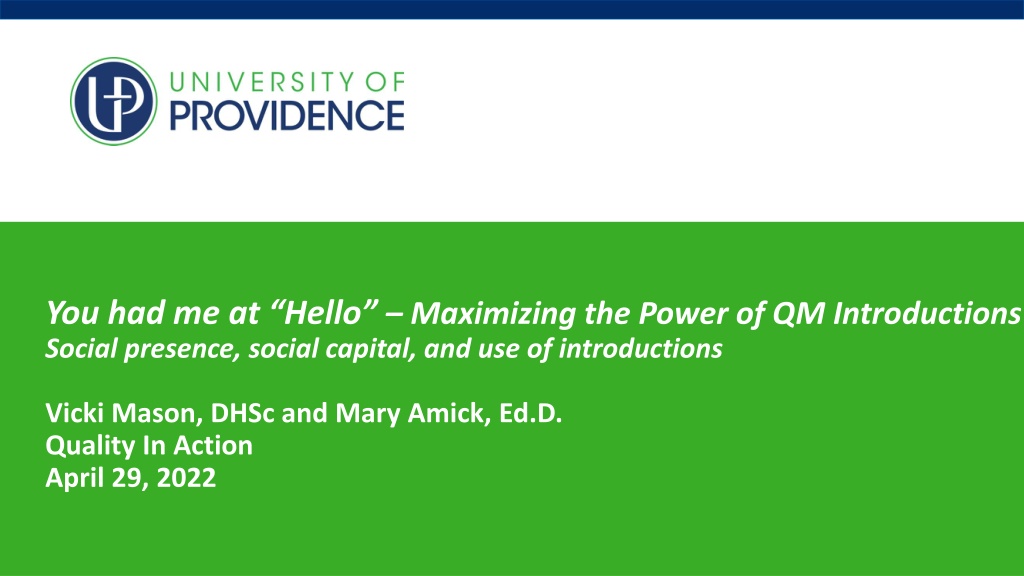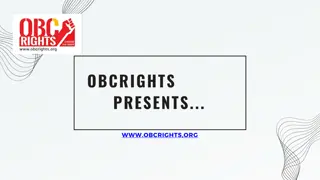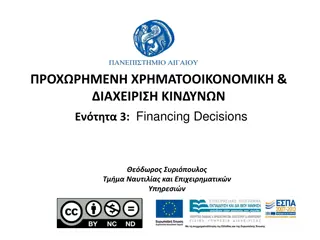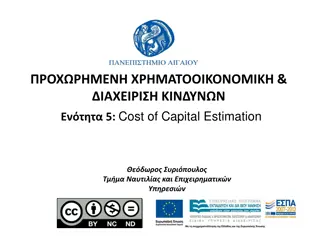Leveraging Social Presence and Social Capital Through Introductions in Education
Explore the significance of social presence and social capital in educational introductions, emphasizing their impact on course satisfaction and learning outcomes. Discover tools for measuring social presence and delve into the importance of fostering connection among learners. Learn how introductions can build a sense of community and enhance the overall educational experience.
Download Presentation

Please find below an Image/Link to download the presentation.
The content on the website is provided AS IS for your information and personal use only. It may not be sold, licensed, or shared on other websites without obtaining consent from the author. Download presentation by click this link. If you encounter any issues during the download, it is possible that the publisher has removed the file from their server.
E N D
Presentation Transcript
You had me at Hello Maximizing the Power of QM Introductions Social presence, social capital, and use of introductions Vicki Mason, DHSc and Mary Amick, Ed.D. Quality In Action April 29, 2022
1) Define social presence and social capital in order to envision the potential of introductions. Learning Objectives 2) Identify tools for measuring social presence in order to gather data and assess success.
A QM Connect 2019 Grapevine, Texas session featuring a motorcycle riding petite instructor/presenter who incorporated "Two Truths and a Lie" as a fun Introduction prompt became our inspiration! Our Journey Now we use the QM mandated introduction to build and measure social presence and social capital in a cohort model.
QM General Standard 1.9 Section: Course Overview and Introduction Standard: Learners are asked to introduce themselves to the class. Specific Review Standards from the QM Higher Education Rubric, Sixth Edition https://www.qualitymatters.org/sites/default/files/PDFs/StandardsfromtheQMHigherEducationRubric.pdf
Why is the Introduction Important? Consulting the literature
Social presence is related to the individual s perception of how they feel in interaction with others (Kim, 2011, p. 764) or a perception that others are real and there (Lowenthal & Dunlap, 2018, p. 282). Social Social Presence Presence https://pixabay.com/illustrations/women-laptop-people-internet-2654514/
Social presence seemed to contribute the most in predicting the level of course satisfaction amongst the students, (Nasir, 2020, p.485) and significantly contributes to the success or failure of e-learning (p. 489). Social Social Presence Presence https://pixabay.com/illustrations/women-laptop-people- internet-2654514/
Social Capital Social Capital Bonding social capital with co-students mostly enhanced students feeling of belonging and supported student retention. (Jensen & Jetten, 2015, p.9). Social capital reflects the value derived from membership. (Jensen & Jetten, 2015, p.2).
Because you have so little time to socialise with your friends and family, socialisation within the course takes on an added significance and graduates used this social network to keep each other going, to rekindle their motivation when the going got tough or they felt particularly isolated. (Delaney & Brown, 2018, p. 219) Social Capital Social Capital https://pixabay.com/illustrations/women-laptop-people- internet-2654514/
78.05% are more likely to remain at their institution and persist to graduation if a sense of belonging is established, (Lee, 2017, p. 13) Retention Retention https://pixabay.com/illustrations/women-laptop-people-internet-2654514/
Connect early and stay connected (Feldman, 2021) Retention and Retention and Belonging Belonging Build a sense of community (Eriksen, 2020) https://pixabay.com/illustrations/women-laptop-people-internet-2654514/
Prompts Three Categories
Course-related Course-related fun Just plain fun Our Three Categories of Prompts Intentional selection of prompts for each course with judicious use of audio/video introductions.
Is the course an undergraduate or graduate course? Strategic considerations for Prompts Is the course early in sequences or later in sequences? Complexity of the subject affected if a more serious or more fun prompt was offered. Comments and concerns about topics shared in advising sessions.
Which of the Table of Contents topics are you most interested in and why? Rationale: Faculty insights and emphasis Course- Related Prompts We can better balance course content with student interest. Facilitates proactive planning with course evaluation considerations. Please share a course-related prompt that you use with the group!
Self-confidence ratings ranging from math phobic to future finance guru for the finance course. Rationale: Faculty insights and support. Course- We heard during advising sessions for an upcoming semester s finance course that there was considerable concern about the math and finance components. The benefit was a more proactive awareness for faculty regarding presentation of topics and to offer help and encouragement. Related Fun Prompts Please share a course Please share a course- -related fun prompt that related fun prompt that you use with the group! you use with the group!
Also used on a limited basis as ice breakers in the optional synchronous sessions to further community -- What is the most fun you have ever had.., that you can talk about? What is your favorite type of music? Just Plain Fun Prompts Two truths and a tall tale What is your favorite cookie? Rationale: Learn about your classmates find commonality Please share a fun prompt that you use with the group!
But Does it Work? Pilot survey
Methods The survey was informed by Kim, (2010), Lowenthal & Dunlap (2018) and McCoy (2021). The survey was piloted with 74 students and yielded a 16% response. A 5-point Likert scale was used. Open-ended questions were asked as follow up
One section focused on perceptions regarding instructional techniques (i.e., synchronous sessions, group projects, discussions, peer review of projects and assignments, introductions) and feeling a part of the learning community. Methods (continued)
Results Strongly disagree Disagree Neutral Agree Strongly agree Course introductions help me feel connected to my instructors and course colleagues 0 8.3% 8.3% 33.3% 50% I feel a part of the learning community in my program 0 0 16.6% 41.7% 41.7%
Follow Up: What is the best introductory question an instructor has ever asked and What s your family holiday tradition? - It made the class more personal. What would you bring to a potluck? - The question and answers made me relax and feel more connected. Are you a dog or cat person? - It gave me a connection with peers, and I liked hearing the stories of other people s pets. why? Do you have any Do you have any prompts to share prompts to share with our group? with our group?
Timing of the survey is important Methods Lessons Learned for Future Surveys Introductions fresh in mind Don t overlap with course evaluations during the semester
Methods (Lessons Learned Timing ) IRB internal process (allow time to complete and submit the application and receive approval) Exempt and part of program evaluation Distribution: Who will send it to all all students in the program/classes? Will this be done by your department s office or a particular support team/person?
Methods (Lessons Learned Timing ) Reminders are important to increase participation Who will send reminders to all all students in the program/classes? Will this be done by your department s office or a particular support team/person? Ask faculty to reiterate participation
Encouragement : Our message Research Survey covered: Synchronous sessions, group projects, discussions, peer review of projects and assignments, introductions) and feeling a part of the learning community What has had the most impact on helping you feel connected to instructors and course colleagues? Why? Help us enhance the program
While further investigation While further investigation is needed preliminary data is needed preliminary data suggest that QM suggest that QM introductions offer benefit introductions offer benefit in building social presence in building social presence and social capital. and social capital. Conclusion 1
QM General Standard 1.9 Course QM General Standard 1.9 Course Overview and Introduction Overview and Introduction Learners are asked to introduce Learners are asked to introduce themselves to the class. themselves to the class. Conclusion 2 Only ONE point on the rubric but Only ONE point on the rubric but INVALUABLE to students, faculty INVALUABLE to students, faculty and organizations. and organizations. Specific Review Standards from the QM Higher Education Rubric, Sixth Edition. https://www.qualitymatters.org/sites/default/files/PDFs/StandardsfromtheQMHigherEducationRubric.pdf
References Delaney, L., & Brown, M. (2018). To walk invisible: distance students in a dual- mode university*. Distance Education, 39(2), 209 223 Jensen, D., & Jetten, J. (2015). Bridging and bonding interactions in higher education: Social capital and students' academic and professional identity formation. Frontiers in Psychology. 6,126 doi:10.3389/fpsyg.2015.00126 Kim, J. (2010). Developing an instrument to measure social presence in distance higher education. British Journal of Educational Technology. 42(5), 763-777. doi:10.1111/j.1437-8535.2010.01107.x
References Lowenthal, P.R., & Dunlap, J.C. (2018). Investigating students perceptions of instructional strategies to establish social presence. Distance Education. 39 (3), 281-298. doi:10.1080/01587919/.2018.1476844 McCoy, S. (2021). Relationship between the length of the course (term), collaboration, social presence, and satisfaction among RN-BSN students in a cohort-based online environment. Unpublished doctoral thesis. Nasir, M. (2020). The influence of social presence on students' satisfaction toward online course. Open Praxis, 12(4), 485-493.
References and Read More on Retention Crosling, G., Heagney, M., Thomas, L. (2009). Improving student retention in higher education, Improving teaching and learning. Australian Universities Review, vol.51, no 2. Accessed online at https://files.eric.ed.gov/fulltext/EJ864028.pdf Ericksen, K. (2020). 8 Overlooked Factors Affecting College Persistence and Retention. Collegis Education. Accessed online April 18, 2022, at https://collegiseducation.com/news/programs-and- course-content/college-persistence-and-retention/ Feldman, G. (2021). Help! 12 Ways to Improve Student Retention in Higher Education. Accessed online April 18, 2022 at https://www.leadsquared.com/improve-student-retention-higher-education/ Heyman, E. (2010). Overcoming Student Retention Issues in Higher Education Online Programs. Online Journal of Distance Learning Administration, 13(4). Retrieved April 19, 2022 from https://www.learntechlib.org/p/52610/.
Questions? Questions? Collaborations Collaborations Vicki.Mason@uprovidence.edu Vicki.Mason@uprovidence.edu Mary.Amick@uprovidence.edu Mary.Amick@uprovidence.edu
Thank you! Thank you!























